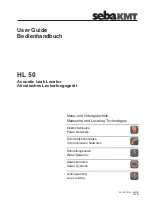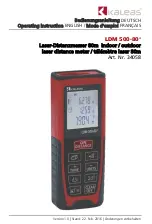
12
Operation
When conducting a measurement with the internal sensor, the noise is recorded with the
probe tip
.
The probe tip can be removed. If needed, you can unscrew it (right-hand thread) and
replace it with another probe, or you can install the supplied prolongation sticks between
the probe tip and the sensor.
Via the 5-pole socket
at the bottom side of the device, an external sensor can be
connected to the HL 50, e.g. the universal microphone PAM B-2. (There are more
sensors available from the optional accessories by SebaKMT.)
When connecting an external sensor, the HL 50 needs to be switched off. Pay attention
to the marks on the plug and the socket. The plug needs to lock tangibly.
When the HL 50 is switched on, it automatically recognises the external sensor. From
that moment, the values of the external sensor are indicated on the display.
Alternating between the internal and external sensor while operating the device is not
possible.
After removing the external sensor, the HL 50 does not automatically switch back to the
internal sensor. The device needs to be restarted for this purpose. Then the values of
the internal sensor are shown in the display again.
By clicking the button
the user can switch between the three following
frequency filter settings during the measurement:
Designation Range
Description
LO
0 ... 540 Hz
High frequencies are cut;
(for operation as ground microphone)
HI
540 … 4000 Hz
Low frequencies are cut;
(for operation as test rod directly on the pipe or
valve etc.)
ALL
0 ... 4000 Hz
Broadband measurement without filter
Measurement using the
probe tip
Measurement using an
external sensor
Frequency filter
Summary of Contents for HL 50
Page 4: ...4...
Page 5: ...5 English...
Page 6: ...6...
Page 14: ...14...
Page 15: ...15 Deutsch...
Page 16: ...16...
Page 24: ...24...











































